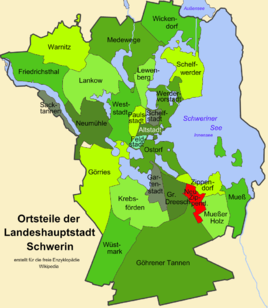New Zippendorf
|
New Zippendorf
City of Schwerin
Coordinates: 53 ° 35 ′ 53 ″ N , 11 ° 27 ′ 1 ″ E
|
|
|---|---|
| Residents : | 5287 (Sep 30, 2017) |
| Postal code : | 19063 |
| Area code : | 0385 |
|
Location of Neu Zippendorf in Schwerin
|
|
Neu Zippendorf is a district of the Mecklenburg-Western Pomerania state capital Schwerin .
After the fall of the Wall, Neu Zippendorf emerged from the Großer Dreesch , when it was divided into the districts of Großer Dreesch, Neu Zippendorf and Mueßer Holz according to its three construction phases .
location
The district of Neu Zippendorf is located in the southeast of the city south of the Schweriner See . In the north, Neu Zippendorf borders on the district of Zippendorf , in which the zoo and a beach are located; the Große Dreesch and the wooded districts of Göhrener Tannen and Mueßer Holz also border on Neu Zippendorf.
history
Even before construction began, the Schwerin television tower with a tower café and the neighboring transmission mast were built in the area of the future district by 1964 . Construction began on the second phase of the Great Dreesch on February 5, 1976. A total of 5400 residential units in panel construction were to be built for around 16,000 residents , which were mainly needed for workers in the Schwerin-Süd industrial area. The apartments belong to the municipal housing association in Schwerin and the housing association Schwerin. In addition to the usual infrastructural facilities, the district party school , popularly known as the Apache Hill , was established in 1979 . A massive austerity policy that began in 1979 prevented planned public buildings, such as the construction of a swimming pool or a tourist hotel. Instead, gaps were built with the five-storey buildings common in GDR times. Only a traffic-free zone from the local recreation area on Lake Schwerin in Zippendorf to the vicinity of the television tower as well as shopping and service facilities on Berliner Platz, which was inaugurated on May 1, 1987, were offered to the residents.
Since the fall of the Wall, the three construction phases of the former Großer Dreesche have been considered a social hotspot with increased crime and unemployment rates. In the context of the urban redevelopment east, which is supported with funds from the federal government, the state and the city, attempts are being made to create higher quality and larger apartments and a more appealing living environment through demolition and conversion. In particular around Berliner Platz, extensive demolitions of the residential high-rises are planned, which are to be implemented from spring 2017. The Neu Zippendorf center could then be redeveloped. [outdated]
Attractions
Transport links
Three of the four tram lines of the Schwerin local transport run in the district , there are also inner-city bus connections with the lines 13 and 16. The surrounding area connection is guaranteed by the line 6 and the line 119 served by SGS Bus & Reisen. Bundesstraße 321 runs along the north-western boundary of the district . The streets were named primarily after cities in Eastern Europe (e.g. Tallinn , Pécs ) and Eastern Germany ( Rostock , Magdeburg , Cottbus etc.).
Sons and daughters
- Günter Millahn (1930–2018), forester, educator and hunter
literature
- Bernd Kasten and Jens-Uwe Rost: Schwerin. History of the city. Thomas Helms Verlag, Schwerin 2005. ISBN 3-935749-38-4 .
- State capital Schwerin: district in transition - Großer Dreesch, Neu Zippendorf, Mueßer Holz . Schwerin 2002.
Web links
Individual evidence
- ↑ What will happen to Berliner Platz? , Schweriner Volkszeitung , January 13, 2015




